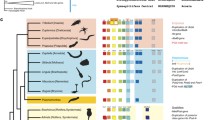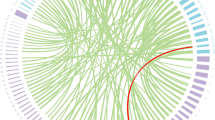Abstract
Partial homeobox gene fragments were amplified from Patiriella exigua genomic DNA by PCR using degenerate primers. The primers spanned a region of 82 nucleotides within the homeobox, encompassing amino acids 21–47 of the homeodomain. The deduced amino acid sequences of the seven Hox gene sequences plus one Xlox-type gene sequence from P. exigua are presented and compared with similar sequences from other organisms. This work is a preliminary step in the analysis of the evolution of development in the Patiriella species group and the roles of Hox gene expression therein.
Similar content being viewed by others
References
Arenas-Mena, C., P. Martinez, R. A. Cameron & E. H. Davidson, 1998. Expression of the Hox gene complex in the indirect development of a sea urchin. Proc. natnl. Acad. Sci. U.S.A. 95: 13062–13067.
Bürglin, T. R., 1994. A comprehensive classification of the homeobox genes. In Duboule, D. (ed.), Guidebook to the Homeobox Genes. Sambrook & Tooze Publications, London: 27–71.
Byrne, M., 1995. Changes in larval morphology in the evolution of benthic development by Patiriella exigua (Asteroidea: Asterinidae), a comparison with the larvae of Patiriella species with planktonic development. Biol. Bull. 188: 293–305.
Byrne, M., 1996. Viviparity and intragonadal cannibalism in the dimunitive sea stars Patiriella vivipara and P. parvivipara (family Asterinidae). Mar. Biol. 125: 551–567.
Di Bernardo, M., R. Russo, P. Oliveri, R. Melfi & G. Spinelli, 1994. Expression of homeobox-containing genes in the sea urchin (Paracentrotus lividus) embryo. Genetica 94: 141–150.
Dobias, S. L., A. Z. Zhao, H.-Y. Tan, J. R. Bell & R. Maxson, 1996. SpHbox7, a newAbd-B class homeobox gene from the sea urchin Strongylocentrotus purpuratus: insights into the evolution of Hox gene expression and function. Devl. Dynam. 207: 450–460.
Dolecki, G. J., S. Wannakrairoj, R. Lum, G. Wang, H. D. Riley, R. Carlos, A. Wang & T. Humphreys, 1986. Stage-specific expression of a homeo box-containing gene in the non-segmented sea urchin embryo. EMBO J. 5: 925–930.
Dolecki, G. J., G. Wang & T. Humphreys, 1988. Stage-and tissue-specific expression of two homeobox genes in sea urchin embryos and adults. Nucl. Acids Res. 16: 11543–11558.
Duboule, D., 1994. Guidebook to the Homeobox Genes. Sambrook & Tooze Publications, London.
Garcia-Fernandez, J. & P. J. Holland, 1994. Archetypal organization of the amphioxus Hox gene cluster. Nature 370: 563–566.
Gellon, G. & W. McGinnis, 1998. Shaping animal body plans in development and evolution by modulation of Hox expression patterns. BioEssays 20: 116–125.
Hart, M. W., M. Byrne & M. J. Smith, 1997. Molecular phylogenetic analysis of life history evolution in asterinid starfish. Evolution 51: 1848–1861.
Martinez P., J. P. Rast, C. Arenas-Mena & E. H. Davidson, 1999. Organization of an echinoderm Hox gene cluster. Proc. natnl. Acad. Sci. U.S.A. 96: 1469–1474.
McGinnis, W. & R. Krumlauf, 1992. Homeobox genes and axial patterning. Cell 68: 283–302.
Mito, T. & K. Endo, 1997. A PCR survey of Hox genes in the sea star Asterina minor. Mol. Phylogenet. Evol. 8: 218–224.
Morris, V. B., J. Brammall, M. Byrne & M. Frommer, 1997. Hox-type and non-Hox homeobox gene sequences in genomic DNA of the sea urchin Holopneustes purpurescens. Gene 201: 107–110.
Pendleton, J. W., B. K. Nagai, M. T. Murtha & F. H. Ruddle, 1993. Expansion of the Hox gene family and the evolution of chordates. Proc. natnl. Acad. Sci. U.S.A. 90: 6300–6304.
Pfeffer, P. L. & C. von Holt, 1991. Stage-and adult tissue-specific expression of a homeobox gene in embryo and adult Parechinus angulosus sea urchins. Gene 108: 219–226.
Popodi, E., J. C. Kissinger, M. E. Andrews & R. A. Raff, 1996. Sea urchin Hox genes: insights into the ancestral Hox cluster. Mol. Biol. Evol. 13: 1078–1086.
Sambrook J., E. F. Fritsch E. & T. Maniatis, 1989. Molecular Cloning-a Laboratory Manual (2nd edn). Cold Spring Harbor Laboratory Press, Cold Spring Harbor.
Scott, M. P., 1992. Vertebrate homeobox gene nomenclature. Cell 71: 551–553.
Wang, G. V. L., G. J. Dolecki, R. Carlos & T. Humphreys, 1990. Characterization and expression of two sea urchin homeobox gene sequences. Devl. Genet. 11: 77–87.
Wu, J.-Y., C.-P. Chen, C.-F. Hui, S.-P. L. Hwang & D. J. Miller, 1998. Preliminary studies on Hox-type homeoboxes in the echinoids Stomopneustes variolaris and Tripneustes gratilla. In Mooi, R. & M. Telford (eds), Echinoderms: San Francisco. Balkema, Rotterdam: 893 pp.
Zhao, A. Z., G. Vansant, J. Bell, T. Humphreys & R. Maxson, 1991. Activation of the L1 late H2B histone gene in blastula-stage sea urchin embryos by an Antennapedia-class homeoprotein. Mech. Devel. 34: 21–28.
Author information
Authors and Affiliations
Rights and permissions
About this article
Cite this article
Long, S.C., Morris, V.B. & Byrne, M. Seven Hox gene sequences from the asterinid starfish Patiriella exigua (Echinodermata: Asteroidea). Hydrobiologia 420, 95–98 (2000). https://doi.org/10.1023/A:1003937704788
Issue Date:
DOI: https://doi.org/10.1023/A:1003937704788




